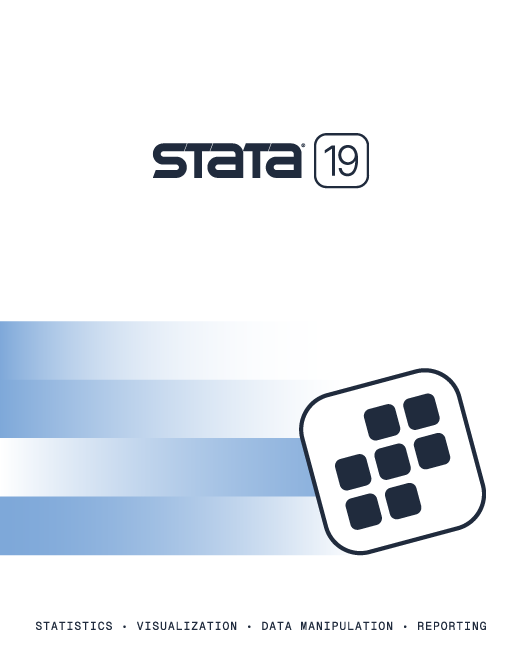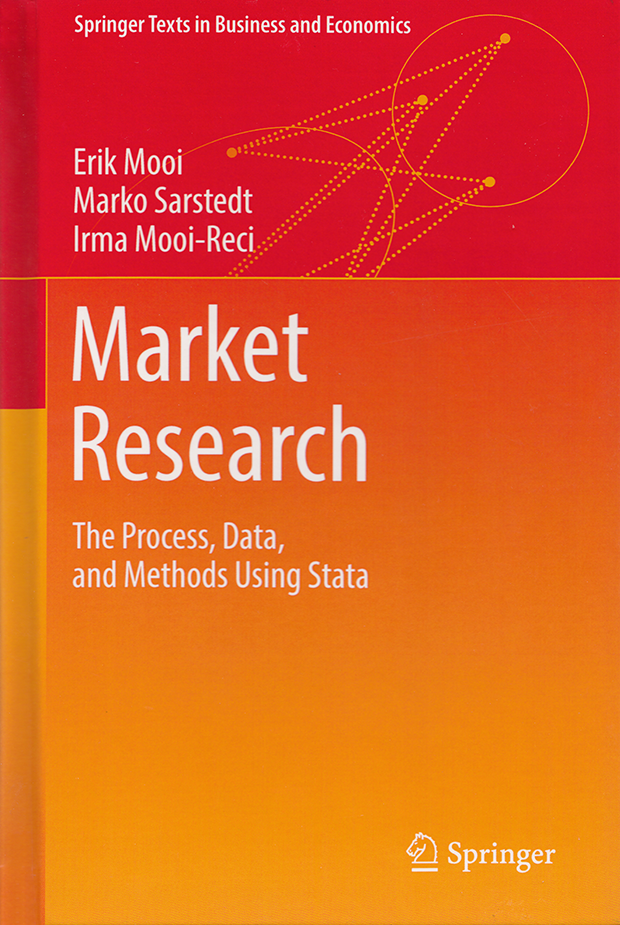

2025 Stata Conference • Nashville, TN • 31 July–01 August
Market Research: The Process, Data, and Methods Using Stata |
||||||||||||||||||||||||||||||||||||
 Click to enlarge See the back cover |

As an Amazon Associate, StataCorp earns a small referral credit from
qualifying purchases made from affiliate links on our site.
eBook not available for this title
eBook not available for this title |
|
||||||||||||||||||||||||||||||||||
Comment from the Stata technical groupMarket Research: The Process, Data, and Methods Using Stata, by Erik Mooi, Marko Sarstedt, and Irma Mooi-Reci, is an easy-to-follow guide to performing market research. The authors walk readers through the entire market research process, including identification of a research question, data collection, analysis, and reporting of results. As they discuss data analysis, the authors introduce statistical techniques that are commonly used in market research and demonstrate how to perform each of these using Stata. The book begins with an introduction to market research followed by a discussion of data and how they are collected. The authors are careful to point out important data-related considerations, such as sample size, validity of measurements, and measurement error. Next, readers are introduced to descriptive statistics and to Stata. The following chapters cover hypothesis testing, regression, factor analysis, and cluster analysis. The authors describe these techniques and provide corresponding examples. These examples demonstrate the Stata commands and include step-by-step instructions to performing the analyses using Stata's menus and dialog boxes. The book concludes with a chapter on reporting results, which is the final stage of the research process. |
||||||||||||||||||||||||||||||||||||
Table of contentsView table of contents >> 1 Introduction to Market Research
1.1 Introduction
1.2 What Is Market and Marketing Research? 1.3 Market Research by Practitioners and Academics 1.4 When Should Market Research (Not) Be Conducted? 1.5 Who Provides Market Research? 1.6 Review Questions 1.7 Further Readings References 2 The Market Research Process
2.1 Introduction
2.2 Identify and Formulate the Problem 2.3 Determine the Research Design
2.3.1 Exploratory Research
2.4 Design the Sample and Method of Data Collection2.3.2 Uses of Exploratory Research 2.3.3 Descriptive Research 2.3.4 Uses of Descriptive Research 2.3.5 Causal Research 2.3.6 Uses of Causal Research 2.5 Collect the Data 2.6 Analyze the Data 2.7 Interpret, Discuss, and Present the Findings 2.8 Follow-Up 2.9 Review Questions 2.10 Further Readings References 3 Data
3.1 Introduction
3.2 Types of Data
3.2.1 Primary and Secondary Data
3.3 Unit of Analysis3.2.2 Quantitative and Qualitative Data 3.4 Dependence of Observations 3.5 Dependent and Independent Variables 3.6 Measurement Scaling 3.7 Validity and Reliability
3.7.1 Types of Validity
3.8 Population and Sampling3.7.2 Types of Reliability
3.8.1 Probability Sampling
3.9 Sample Sizes3.8.2 Non-probability Sampling 3.8.3 Probability or Non-probability Sampling? 3.10 Review Questions 3.11 Further Readings References 4 Getting Data
4.1 Introduction
4.2 Secondary Data
4.2.1 Internal Secondary Data
4.3 Conducting Secondary Data Research4.2.2 External Secondary Data
4.3.1 Assess Availability of Secondary Data
4.4 Conducting Primary Data Research4.3.2 Assess Inclusion of Key Variables 4.3.3 Assess Construct Validity 4.3.4 Assess Sampling
4.4.1 Collecting Primary Data Through Observations
4.5 Basic Qualitative Research4.4.2 Collecting Quantitative Data: Designing Surveys
4.5.1 In-Depth Interviews
4.6 Collecting Primary Data Through Experimental Research4.5.2 Projective Techniques 4.5.3 Focus Groups
4.6.1 Principles of Experimental Research
4.7 Review Questions4.6.2 Experimental Designs 4.8 Further Readings References 5 Descriptive Statistics
5.1 The Workflow of Data
5.2 Create Structure 5.3 Enter Data 5.4 Clean Data
5.4.1 Interviewer Fraud
5.5 Describe Data5.4.2 Suspicious Response Patterns 5.4.3 Data Entry Errors 5.4.4 Outliers 5.4.5 Missing Data
5.5.1 Univariate Graphs and Tables
5.6 Transform Data (Optional)5.5.2 Univariate Statistics 5.5.3 Bivariate Graphs and Tables 5.5.4 Bivariate Statistics
5.6.1 Variable Respecification
5.7 Create a Codebook5.6.2 Scale Transformation 5.8 The Oddjob Airways Case Study
5.8.1 Introduction to Stata
5.9 Data Management in Stata5.8.2 Finding Your Way in Stata
5.9.1 Restrict Observations
5.10 Example5.9.2 Create a New Variable from Existing Variable(s) 5.9.3 Recode Variables
5.10.1 Clean Data
5.11 Cadbury and the UK Chocolate Market (Case Study)5.10.2 Describe Data 5.12 Review Questions 5.13 Further Readings References 6 Hypothesis Testing & ANOVA
6.1 Introduction
6.2 Understanding Hypothesis Testing 6.3 Testing Hypotheses on One Mean
6.3.1 Step 1: Formulate the Hypothesis
6.4 Two-Samples t-Test6.3.2 Step 2: Choose the Significance Level 6.3.3 Step 3: Select an Appropriate Test 6.3.4 Step 4: Calculate the Test Statistic 6.3.5 Step 5: Make the Test Decision 6.3.6 Step 6: Interpret the Results
6.4.1 Comparing Two Independent Samples
6.5 Comparing More Than Two Means: Analysis of Variance (ANOVA)6.4.2 Comparing Two Paired Samples 6.6 Understanding One-Way ANOVA
6.6.1 Check the Assumptions
6.7 Going Beyond One-Way ANOVA: The Two-Way ANOVA6.6.2 Calculate the Test Statistic 6.6.3 Make the Test Decision 6.6.4 Carry Out Post Hoc Tests 6.6.5 Measure the Strength of the Effects 6.6.6 Interpret the Results and Conclude 6.6.7 Plotting the Results (Optional) 6.8 Examples
6.8.1 Independent Samples t-Test
6.9 Customer Analysis at Crédit Samouel (Case Study)6.8.2 One-way ANOVA 6.8.3 Two-way ANOVA 6.10 Review Questions 6.11 Further Readings References 7 Regression Analysis
7.1 Introduction
7.2 Understanding Regression Analysis 7.3 Conducting a Regression Analysis
7.3.1 Check the Regression Analysis Data Requirements
7.4 Example7.3.2 Specify and Estimate the Regression Model 7.3.3 Test the Regression Analysis Assumptions 7.3.4 Interpret the Regression Results 7.3.5 Validate the Regression Results 7.3.6 Use the Regression Model
7.4.1 Check the Regression Analysis Data Requirements
7.5 Farming with AgriPro (Case Study)7.4.2 Specify and Estimate the Regression Model 7.4.3 Test the Regression Analysis Assumptions 7.4.4 Interpret the Regression Results 7.4.5 Validate the Regression Results 7.6 Review Questions 7.7 Further Readings References 8 Principal Component and Factor Analysis
8.1 Introduction
8.2 Understanding Principal Component and Factor Analysis
8.2.1 Why Use Principal Component and Factor Analysis?
8.3 Principal Component Analysis8.2.2 Analysis Steps
8.3.1 Check Requirements and Conduct Preliminary Analyses
8.4 Confirmatory Factor Analysis and Reliability Analysis8.3.2 Extract the Factors 8.3.3 Determine the Number of Factors 8.3.4 Interpret the Factor Solution 8.3.5 Evaluate the Goodness-of-Fit of the Factor Solution 8.3.6 Compute the Factor Scores 8.5 Structural Equation Modeling 8.6 Example
8.6.1 Principal Component Analysis
8.7 Customer Satisfaction at Haver and Boecker (Case Study)8.6.2 Reliability Analysis 8.8 Review Questions 8.9 Further Readings References 9 Cluster Analysis
9.1 Introduction
9.2 Understanding Cluster Analysis 9.3 Conducting a Cluster Analysis
9.3.1 Select the Clustering Variables
9.4 Example9.3.2 Select the Clustering Procedure 9.3.3 Select a Measure of Similarity of Dissimilarity 9.3.4 Decide on the Number of Clusters 9.3.5 Validate and Interpret the Clustering Solution
9.4.1 Select the Clustering Variables
9.5 Oh, James! (Case Study)9.4.2 Select the Clustering Procedure and Measure of Similarity or Dissimilarity 9.4.3 Decide on the Number of Clusters 9.4.4 Validate and Interpret the Clustering Solution 9.6 Review Questions 9.7 Further Readings References 10 Communicating the Results
10.1 Introduction
10.2 Identify the Audience 10.3 Guidelines for Written Reports 10.4 Structure the Written Report
10.4.1 Title Page
10.5 Guidelines for Oral Presentations10.4.2 Executive Summary 10.4.3 Table of Contents 10.4.4 Introduction 10.4.5 Methodology 10.4.6 Results 10.4.7 Conclusion and Recommendations 10.4.8 Limitations 10.4.9 Appendix 10.6 Visual Aids in Oral Presentations 10.7 Structure the Oral Presentation 10.8 Follow-Up 10.9 Ethics in Research Reports 10.10 Review Questions 10.11 Further Readings References Glossary
Index
|
||||||||||||||||||||||||||||||||||||
Learn
Free webinars
NetCourses
Classroom and web training
Organizational training
Video tutorials
Third-party courses
Web resources
Teaching with Stata
© Copyright 1996–2025 StataCorp LLC. All rights reserved.
×
We use cookies to ensure that we give you the best experience on our website—to enhance site navigation, to analyze usage, and to assist in our marketing efforts. By continuing to use our site, you consent to the storing of cookies on your device and agree to delivery of content, including web fonts and JavaScript, from third party web services.
Cookie Settings
Last updated: 16 November 2022
StataCorp LLC (StataCorp) strives to provide our users with exceptional products and services. To do so, we must collect personal information from you. This information is necessary to conduct business with our existing and potential customers. We collect and use this information only where we may legally do so. This policy explains what personal information we collect, how we use it, and what rights you have to that information.
These cookies are essential for our website to function and do not store any personally identifiable information. These cookies cannot be disabled.
This website uses cookies to provide you with a better user experience. A cookie is a small piece of data our website stores on a site visitor's hard drive and accesses each time you visit so we can improve your access to our site, better understand how you use our site, and serve you content that may be of interest to you. For instance, we store a cookie when you log in to our shopping cart so that we can maintain your shopping cart should you not complete checkout. These cookies do not directly store your personal information, but they do support the ability to uniquely identify your internet browser and device.
Please note: Clearing your browser cookies at any time will undo preferences saved here. The option selected here will apply only to the device you are currently using.